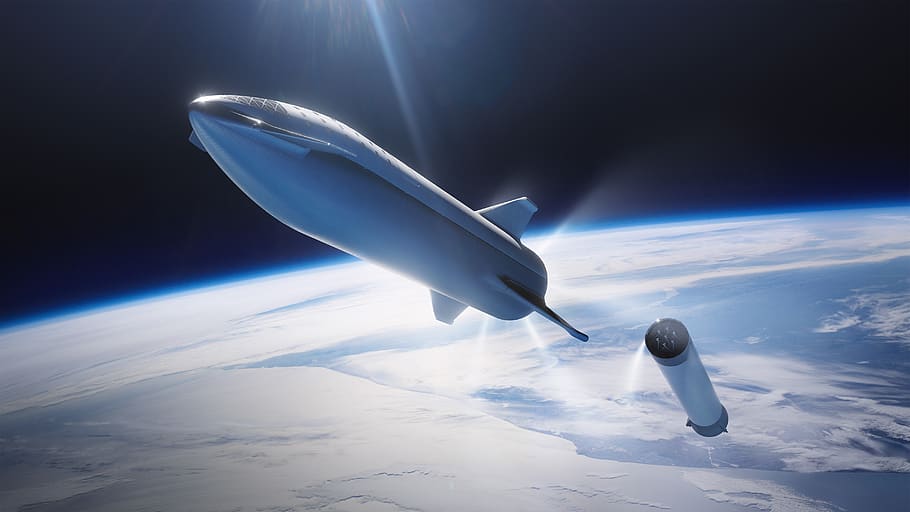Twin paradox
 |
| https://www.pxfuel.com/en/free-photo-xnsas |
In 1905, Albert Einstein published his first paper on the theory of special relativity, which is based upon two postulates:
1. The laws of physics are the same in all inertial frames of reference
2. The speed of light is invariant in any inertial frame of reference
Inertial frames of reference can be considered ones which
are ‘neither accelerating nor rotating with respect to the distant galaxies.’ [1]
Two direct consequences of these postulates are time dilation and length
contraction. Time dilation refers to the apparent slowing down of a clock, from
the perspective of an observer who is in relative motion with it. The factor by
which time is dilated is called the Lorentz factor, calculated using the
following equation [2]:
Similarly, lengths of moving objects are contracted, from
the perspective of a stationary observer, by the same Lorentz factor. From the
above equation, you can see that the Lorentz factor is approximately 1 for all
everyday objects and so we do not usually notice time dilation or length
contraction. For these effects to become more apparent, you have to approach
the speed of light.
Einstein’s theory is an extension of Galileo’s principle of
relativity which stated that the laws of mechanics are the same in all inertial
frames of reference. Thus, there is no experiment that can be done to determine
whether you are moving or at rest.
The Twin Paradox
The twin paradox is a thought experiment surrounding special relativity. It involves twin A staying on Earth while the other, twin B, makes a journey to a star in outer space with a high-speed rocket before returning back to Earth. Twin A, from their own viewpoint, is stationary and they believe that twin B is moving. Therefore, twin A will say that twin B’s light clock will be moving slower. This would mean, that when twin B returns, they are younger than twin A since they have aged a shorter amount of time. However, from twin B’s standpoint, they are stationary and twin A on Earth is the one moving. Hence, twin B will return to Earth expecting twin A to be younger as their light clock slowed down. Therein lies the paradox: one twin has to be either younger or older – they cannot be both.
Light signals [3] [4]
A solution to this problem can also be found if you imagine
that twin A and twin B send light signals to one another every year (that is a
year from their perspective). Say that twin A, on Earth, sends a light signal to
twin B after one year. Since twin B is moving away from twin A in their rocket,
it takes time for the light signal to catch up with twin B. As twin B gets
further and further away, the signals from Earth take longer to reach the
rocket. When twin B begins their return to Earth, they start travelling towards
twin A. This means that the light signals take less time to reach the rocket as the distance travelled decreases.
Therefore, from twin B’s perspective, twin A ages slowly for the first half of
their journey but then they see twin A ageing quickly on their return leg.
Now as we have already mentioned, twin B sees twin A moving
away from them. Length contraction as a result of relative motion causes twin B
to see the distance between the Earth and the destination star shrinking. As a
result, the journey to the star, from twin B’s standpoint takes less time than
it does from twin A’s perspective. On the return leg of the journey, twin A
receives light signals from twin B more quickly due to the decreasing
separation between them. For the majority of the journey, twin A believes that
twin B ages slowly before ageing rapidly during the final portion of the
round-trip.
The diagram below [5] represents this exchange of
light signals:
The blue lines show the light signals being sent by twin B (on the rocket) to twin A every year from twin B’s perspective: you can see the lines reaching A slowly for the majority of the journey before arriving rapidly at the end.
The orange lines show the light signals being sent by twin A (on Earth) to twin B every year from twin A’s perspective.
As you can see, in this scenario both twins agree that twin A has aged 10 years while twin B has only aged 8 years.
Sources:
1. Encyclopædia Britannica: https://www.britannica.com/science/relativistic-mechanics#ref611457
2. Quora: https://www.quora.com/What-is-the-ratio-of-relativistic-mass-to-the-rest-mass
3. TED-Ed (YouTube): https://www.youtube.com/watch?v=h8GqaAp3cGs
4. Wikipedia: https://en.wikipedia.org/wiki/Twin_paradox
5. Proper Physics (WordPress blog): https://properphysics.wordpress.com/2014/05/28/a-no-nonsense-introduction-to-special-theory-of-relativity-part-4/
Comments
Post a Comment